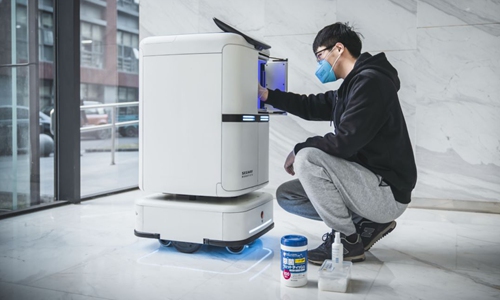HOME >> SOURCE
China's robot industry boosted as demand emerges in fight against coronavirus
By Song Lin Source:Global Times Published: 2020/3/9 16:33:40
Industry boosted as demand emerges in fight against coronavirus

A food delivery robot developed by Segway-Ninebot is sterilized in Zhongguancun Dongsheng Science and Technology Park in Beijing. Photo: Courtesy of Segway-Ninebot
Intelligent robots in China have made a collective appearance amid the coronavirus epidemic with delivery, medical and disinfection purposes, contributing to prevention and control efforts. Experts say that though intelligent robot technology is still in an initial phase, the epidemic has offered a boost to the robot industry.
A food delivery robot with disinfection functions was installed in Zhongguancun Dongsheng Science and Technology Park in Beijing to help deliver food as production gradually resumes. Customers can receive food without direct contact with the robots, as seen in a video sent to the Global Times by the robot's developer Segway-Ninebot, a Beijing-based unicorn focusing on smart mobility.
The robot, Segway DeliveryBot S2, is capable of delivering 300 orders per day at eight minutes per delivery. Multiple robots can work together on tasks dynamically optimized and assigned using cloud control to resolve resource conflicts and improve delivery efficiency, according to the company.
Hunan-based Xingshen Tech has developed a tailored, unmanned delivery carts for the China Post Group Co which have been set up in multiple cities to conduct package delivery services, including Hubei's Xiantao City.
One delivery cart can deliver nearly 100 packages per day, according to Xingshen Tech.
Alongside China's epidemic prevention efforts and its gradually resuming production, the implementation of high-tech factors in the logistics industry will be accelerated, He Hui, director of the China Logistics Information Center, told the Global Times on Sunday.
In addition to delivery services, robots have also been used directly in the fight against the spread of the virus.
Shanghai-based Yogo Robot has rolled out a disinfection robot which can disinfect an area of 100 square meters in as short a time as three minutes, and one such robot can cover 30 floors in a building, read a statement sent to the Global Times by the company on Monday.
In outbreak epicenter Wuhan, a series of multitask robots developed by Shenzhen-based Candela Tech were installed in the two newly built hospitals, Huoshenshan Hospital and Leishenshan Hospital, to deliver medical materials and disinfect, according to a statement posted on the company's official WeChat account.
One disinfection robot can cover the work of four professionals, showed the statement.
When it comes to application scenarios, robots have epidemic prevention advantages as they can efficiently reduce direct contact among people, Ma Jihua, a senior tech industry expert, told the Global Times on Sunday.
The need for contactless delivery and other services has been highlighted during this period, Ma said.
Promotion opportunity
China's robot industry market was valued at an estimated $8.68 billion in 2019, with an average annual growth of 20.9 percent from 2014-19, according to a report from the Xinhua News Agency.
With the rapid development of the 5G network and artificial intelligence (AI) technology in China, the intelligent robot industry has promising prospects, experts noted.
The outbreak has offered a valuable scenario for the realistic application of such high-tech robots, including not only delivery robots but also thermometer robots, medical robots and others, which will definitely be a driving force for the industry, Ma said.
China's Shandong University and Singapore's Nanyang Technological University jointly designed two types of robot specifically for epidemic prevention - one intelligent consultation and delivery robot and one epidemic inspection robot. These robots have been sent to hospitals in Huanggang, another city in Central China's Hubei Province hard hit by the virus, read an online statement from Shandong University published on Sunday.
The team at Shandong University is striving to develop a robot that could replace medical personnel in carrying out close clinical virus sampling and auxiliary examination, per the statement.
The medical sector is a great field for the future development of robot technology, both He and Ma stressed, noting that with the country's aging population and increasing income level, medical robot technology will see a huge market in China.
China's market scale for service robots - including medical robots - hit roughly $2.2 billion in 2019, surging 33.33 percent year-on-year and accounting for 23 percent of the global market, according to report from news site robotchina.com on Friday, citing research results from the Qianzhan Industry Research Institute.
There are many kinds of medical robots in China, including rehabilitation, surgical, and non-therapeutic service robots, among others. The proportion of rehabilitation robots was 42 percent in 2018, followed by auxiliary robots at 17 percent and surgical robots at 16 percent, showed the report.
Further development needed
China has been ramping up efforts to shore up its industrialization, research and development of robot technology. The country has included robotics and intelligent manufacturing in its priority tasks for national scientific and technological innovation, according to Xinhua.
Many manufacturing giants in China have realized high level of automatic production through robotic production lines, such as tech giants Huawei and Lenovo.
China's industrial robots have been the world's largest application market for seven consecutive years, Xinhua said.
Ma told the Global Times that the country's advanced automatic production level, on the other hand, could help factories related to intelligent robots return to normal operations amid the epidemic as the plants have already formed strict and scientific management systems with clean environments.
Intelligent robot technology is still in an initial phase, and many areas are not yet ready for large-scale application. In addition to promotion, the epidemic has also offered the opportunity to test robot developers and see if their products have reached a realistic application phase; It is a chance for them to reveal their development progress, Ma said.
Newspaper headline: Robot workforce takes shape
Posted in: INDUSTRIES,BIZ FOCUS